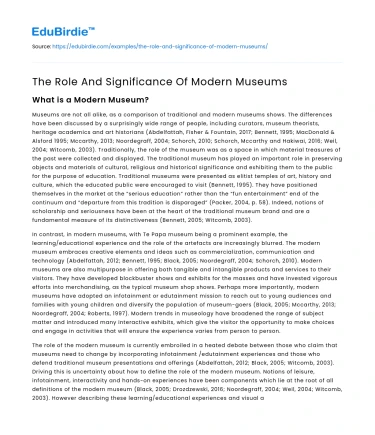What is a Modern Museum?
Museums are not all alike, as a comparison of traditional and modern museums shows. The differences have been discussed by a surprisingly wide range of people, including curators, museum theorists, heritage academics and art historians (Abdelfattah, Fisher & Fountain, 2017; Bennett, 1995; MacDonald & Alsford 1995; Mccarthy, 2013; Noordegraff, 2004; Schorch, 2010; Schorch, Mccarthy and Hakiwai, 2016; Weil, 2004; Witcomb, 2003). Traditionally, the role of the museum was as a space in which material treasures of the past were collected and displayed. The traditional museum has played an important role in preserving objects and materials of cultural, religious and historical significance and exhibiting them to the public for the purpose of education. Traditional museums were presented as elitist temples of art, history and culture, which the educated public were encouraged to visit (Bennett, 1995). They have positioned themselves in the market at the “serious education” rather than the “fun entertainment” end of the continuum and “departure from this tradition is disparaged” (Packer, 2004, p. 58). Indeed, notions of scholarship and seriousness have been at the heart of the traditional museum brand and are a fundamental measure of its distinctiveness (Bennett, 2005; Witcomb, 2003).
In contrast, in modern museums, with Te Papa museum being a prominent example, the learning/educational experience and the role of the artefacts are increasingly blurred. The modern museum embraces creative elements and ideas such as commercialization, communication and technology (Abdelfattah, 2012; Bennett, 1995; Black, 2005; Noordegraff, 2004; Schorch, 2010). Modern museums are also multipurpose in offering both tangible and intangible products and services to their visitors. They have developed blockbuster shows and exhibits for the masses and have invested vigorous efforts into merchandising, as the typical museum shop shows. Perhaps more importantly, modern museums have adopted an infotainment or edutainment mission to reach out to young audiences and families with young children and diversify the population of museum-goers (Black, 2005; Mccarthy, 2013; Noordegraff, 2004; Roberts, 1997). Modern trends in museology have broadened the range of subject matter and introduced many interactive exhibits, which give the visitor the opportunity to make choices and engage in activities that will ensure the experience varies from person to person.
Save your time!
We can take care of your essay
- Proper editing and formatting
- Free revision, title page, and bibliography
- Flexible prices and money-back guarantee
The role of the modern museum is currently embroiled in a heated debate between those who claim that museums need to change by incorporating infotainment /edutainment experiences and those who defend traditional museum presentations and offerings (Abdelfattah, 2012; Black, 2005; Witcomb, 2003). Driving this is uncertainty about how to define the role of the modern museum. Notions of leisure, infotainment, interactivity and hands-on experiences have been components which lie at the root of all definitions of the modern museum (Black, 2005; Drozdzewski, 2016; Noordegraff, 2004; Weil, 2004; Witcomb, 2003). However describing these learning/educational experiences and visual and sensory experiences is not sufficient to explain all the functions of museums. To discover the other roles of modern museums, one needs to look beyond their undeniable educational value and an interactive and fun learning experience, to a range of other visitor motives and experiences. If we know why people visit modern museums and what experiences they take away from the museums, we will learn something about the role of this type of museum for different groups of visitors. Thus, exploring these motives and experiences is essential. The focus of this article now shifts to the theoretical framework of this study.
Motives and the significance of the experience
This section drives primarily from the theoretical contributions of Falk and Dierking (1992, 2004), whose arguments academics resulted in a re-evaluation of the role of today’s modern museum shaping the current study. Our interpretive investigation of their works did not produce narrow definitions or meanings of today’s modern museum such as its equation with education, learning, or infotainment, the achievement of cognitive and edutainment goals as postulated by other scholars (i.e. Leonie & Johnston, 2007; Packer, 2004, 2008; Roberts, 1997). In this way, the perspective that shaped this study was that the roles of today’s modern museum are not just about education, presentation of artefacts and fun learning experiences. Modern museums can also offer recreational/leisure experiences, social experiences, entertainment experiences, personal and memorable experiences and aesthetic experiences. As the function of museums has changed over recent years from focusing on objects to focusing on visitors’ experiences of other museum presentations and offerings, a deeper, more holistic discussion of visitors’ motives and experiences is important.






 Stuck on your essay?
Stuck on your essay?

